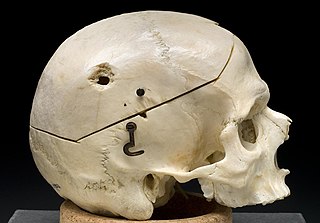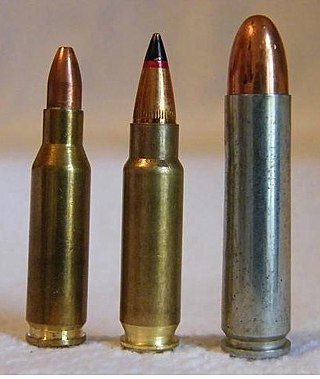Related Research Articles

Hydrostatic shock is the controversial concept that a penetrating projectile can produce a pressure wave that causes "remote neural damage", "subtle damage in neural tissues" and/or "rapid incapacitating effects" in living targets. It has also been suggested that pressure wave effects can cause indirect bone fractures at a distance from the projectile path, although it was later demonstrated that indirect bone fractures are caused by temporary cavity effects.

The 5.56×45mm NATO is a rimless bottlenecked intermediate cartridge family developed in the late 1970s in Belgium by FN Herstal. It consists of the SS109, L110, and SS111 cartridges. On 28 October 1980, under STANAG 4172, it was standardized as the second standard service rifle cartridge for NATO forces as well as many non-NATO countries. Though they are not entirely identical, the 5.56×45mm NATO cartridge family was derived from and is dimensionally similar to the .223 Remington cartridge designed by Remington Arms in the early 1960s.

Terminal ballistics is a sub-field of ballistics concerned with the behavior and effects of a projectile when it hits and transfers its energy to a target.

This is a table of selected pistol/submachine gun and rifle/machine gun cartridges by common name. Data values are the highest found for the cartridge, and might not occur in the same load.

The .40 S&W is a rimless pistol cartridge developed jointly by American firearms manufacturers Smith & Wesson and Winchester in 1990. The .40 S&W was developed as a law enforcement cartridge designed to duplicate performance of the Federal Bureau of Investigation's (FBI) reduced-velocity 10mm Auto cartridge which could be retrofitted into medium-frame semi-automatic handguns. It uses 0.40-inch (10 mm) diameter bullets ranging in weight from 105 to 200 grains.

The .45 ACP or .45 Auto (11.43×23mm) is a rimless straight-walled handgun cartridge designed by John Moses Browning in 1904, for use in his prototype Colt semi-automatic pistol. After successful military trials, it was adopted as the standard chambering for Colt's M1911 pistol. The round was developed due to a lack of stopping power experienced in the Moro Rebellion in places like Sulu. The issued ammunition, .38 Long Colt, had proved inadequate, motivating the search for a better cartridge. This experience and the Thompson–LaGarde Tests of 1904 led the Army and the Cavalry to decide that a minimum of .45 caliber was required in a new handgun.

The .380 ACP (9×17mm) is a rimless, straight-walled pistol cartridge developed by firearms designer John Moses Browning. The cartridge headspaces on the mouth of the case. It was introduced in 1908 by Colt, for use in its new Colt Model 1908 pocket hammerless semi-automatic, and has been a popular self-defense cartridge ever since, seeing wide use in numerous handguns. Other names for .380 ACP include .380 Auto, 9×17mm, 9mm Browning, 9mm Corto, 9mm Kurz, 9mm Short, and 9mm Browning Court. It should not be confused with .38 ACP. The .380 ACP does not strictly conform to cartridge naming conventions, named after the diameter of the bullet, as the actual bullet diameter of the .380 ACP is .355 inches.

The .357 SIG is a bottlenecked rimless centerfire handgun cartridge developed by the Swiss-German firearms manufacturer SIG Sauer, in cooperation with ammunition manufacturer Federal Premium. The cartridge is used by a number of law enforcement agencies.

The .357 Smith & Wesson Magnum, .357 S&W Magnum, .357 Magnum, or 9×33mmR as it is known in unofficial metric designation, is a smokeless powder cartridge with a 0.357 in (9.07 mm) bullet diameter. It was created by Elmer Keith, Phillip B. Sharpe, and Douglas B. Wesson of firearm manufacturers Smith & Wesson and Winchester. The .357 Magnum cartridge is notable for its highly effective terminal ballistics.

Ballistic gelatin is a testing medium designed to simulate the effects of bullet wounds in animal muscle tissue. It was developed and improved by Martin Fackler and others in the field of wound ballistics. It is calibrated to match porcine muscle, which is itself ballistically similar to human muscle tissue.

The 9×19mm Parabellum is a rimless, tapered firearms cartridge.

The .308 Winchester is a smokeless powder rimless bottlenecked rifle cartridge widely used for hunting, target shooting, police, military, and personal protection applications globally. It is similar but not identical to the 7.62×51mm NATO cartridge.

The .41 Remington Magnum, also known as .41 Magnum or 10.4×33mmR, is a center fire firearms cartridge primarily developed for use in large-frame revolvers, introduced in 1964 by the Remington Arms Company, intended for hunting and law enforcement purposes.
Stopping power is the ability of a weapon – typically a ranged weapon such as a firearm – to cause a target to be incapacitated or immobilized. Stopping power contrasts with lethality in that it pertains only to a weapon's ability to make the target cease action, regardless of whether or not death ultimately occurs. Which ammunition cartridges have the greatest stopping power is a much debated topic.

Armor-piercing bullets for rifle and handgun cartridges are designed to penetrate ballistic armor and protective shields intended to stop or deflect conventional bullets. Although bullet design is an important factor with regard to armor penetration, the ability of any given projectile to penetrate ballistic armor increases with increasing velocity. Rifle cartridges typically discharge bullets at higher muzzle velocity than handgun cartridges due to larger propellant charge. However, even the same cartridge fired from a rifle will, in almost all common cases, have a higher velocity than when fired from a handgun. This is due to the longer period of acceleration available within the longer gun barrel of rifles, which allow adequate time for the propellant to fully ignite before the projectile exits the barrel. For this reason, bullets fired from rifles may be more capable of piercing armor than similar or identical bullets fired from handguns. In addition, a small-caliber bullet has higher sectional density than a larger-caliber bullet of the same weight, and thus more capable of defeating body armor.

The .444 Marlin (10.9×57mmR) is a rifle cartridge designed in 1964 by Marlin Firearms and Remington Arms. It was designed to fill in a gap left by the older .45-70 when that cartridge was not available in any new lever-action rifles; at the time it was the largest lever-action cartridge available. The .444 resembles a lengthened .44 Magnum and provides a significant increase in velocity. It is usually used in the Marlin 444 lever-action rifle.

The 7mm Remington Magnum rifle cartridge was introduced as a commercially available round in 1962, along with the new Remington Model 700 bolt-action rifle. It is a member of the belted magnum family that is directly derived from the venerable .375 H&H Magnum. The original purpose of the belted magnum concept taken from the .300 H&H Magnum and .375 H&H Magnum, was to provide precise headspace control, since the sloping shoulders, while easing cartridge extraction, were unsuitable for this purpose. Improved cartridge extraction reliability is desirable while hunting dangerous game, in particular when a fast follow-up shot is required. The 7mm Remington Magnum is based on the commercial .264 Winchester Magnum, .338 Winchester Magnum, and .458 Winchester Magnum, which were based on the same belted .300 H&H Magnum and .375 H&H Magnum cases, trimmed to nearly the same length as the .270 Weatherby Magnum.

A gunshot wound (GSW) is a penetrating injury caused by a projectile from a gun. Damages may include bleeding, bone fractures, organ damage, wound infection, loss of the ability to move part of the body and, in more severe cases, death. Damage depends on the part of the body hit, the path the bullet follows through the body, and the type and speed of the bullet. Long-term complications can include lead poisoning and post-traumatic stress disorder (PTSD).

The 4.6×30mm cartridge is a small-caliber, high-velocity, smokeless powder, rebated rim, bottlenecked centerfire cartridge designed for personal defense weapons (PDW) developed by German armament manufacturer Heckler & Koch (HK) in 1999. It was designed primarily for the MP7 PDW to minimize weight and recoil while increasing penetration of body armor. It features a bottlenecked case and a pointed, steel-core, brass-jacketed bullet.
Ballistics by the Inch was a project to test the performance characteristics of a variety of common handgun calibers/cartridges. The initial testing was done in 2008 and tested the velocity of 13 common handgun cartridges as it related to firearm barrel length. In 2009 an additional three calibers were tested and in 2010 and 2011 more calibers were added. Also in 2011 testing was carried out to study the "cylinder gap effect" on the velocity of ammunition shot from revolvers. All testing has been carried out as carefully as possible with no bias toward any particular manufacturer, caliber, or firearm. In November 2008 the BBTI website went online, describing the tests and making the data freely available so that anyone can dig out any particular bit of information they may be interested in. The website underwent a complete redesign in late 2011 with the addition of the 2011 tests, and even more tests have been done in the years since.
References
- ↑ Jeremy J. Hollerman; Martin L. Fackler; Douglas M. Coldwell; Yoram Ben-Menachem (October 1990). "Gunshot Wounds: 1. Bullets, Ballistics, and Mechanisms of Injury". American Journal of Roentgenology vol.155 no. 4: 685–690.
{{cite journal}}: Cite journal requires|journal=(help) - ↑ Courtney, Michael; Courtney, Amy (2007). "Review of criticisms of ballistic pressure wave experiments, the Strasbourg goat tests, and the Marshall and Sanow data". arXiv: physics/0701268 . Bibcode:2007physics...1268C.
{{cite journal}}: Cite journal requires|journal=(help) - ↑ Courtney, Michael; Courtney, Amy (2007). "Ballistic pressure wave contributions to rapid incapacitation in the Strasbourg goat tests". arXiv: physics/0701267 . Bibcode:2007physics...1267C.
{{cite journal}}: Cite journal requires|journal=(help) - ↑ Courtney, Michael; Courtney, Amy (2007). "Relative incapacitation contributions of pressure wave and wound channel in the Marshall and Sanow data set". arXiv: physics/0701266 . Bibcode:2007physics...1266C.
{{cite journal}}: Cite journal requires|journal=(help) - ↑ Courtney, Michael; Courtney, Amy (2007). "A method for testing handgun bullets in deer". arXiv: physics/0702107 . Bibcode:2007physics...2107C.
{{cite journal}}: Cite journal requires|journal=(help) - ↑ Suneson, A.; Hansson, H. A.; Seeman, T. (1990). "Pressure wave injuries to the nervous system caused by high-energy missile extremity impact: Part I. Local and distant effects on the peripheral nervous system--a light and electron microscopic study on pigs". The Journal of Trauma. 30 (3): 281–94. doi:10.1097/00005373-199003000-00006. PMID 2313747.
- ↑ Suneson, A.; Hansson, H. A.; Seeman, T. (1990). "Pressure wave injuries to the nervous system caused by high-energy missile extremity impact: Part II. Distant effects on the central nervous system--a light and electron microscopic study on pigs". The Journal of Trauma. 30 (3): 295–306. doi:10.1097/00005373-199003000-00007. PMID 2313748.
- ↑ Wang, Q.; Wang, Z.; Zhu, P.; Jiang, J. (2004). "Alterations of myelin basic protein and ultrastructure in the limbic system at the early stage of trauma-related stress disorder in dogs". The Journal of Trauma. 56 (3): 604–10. doi:10.1097/01.ta.0000058122.57737.0e. PMID 15128132.